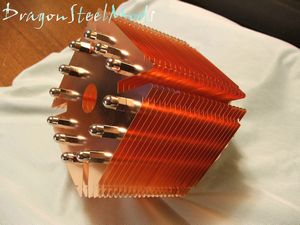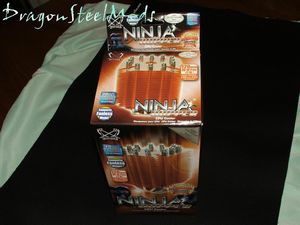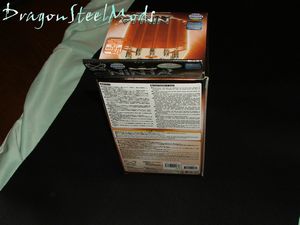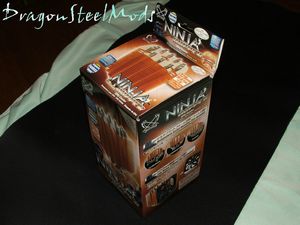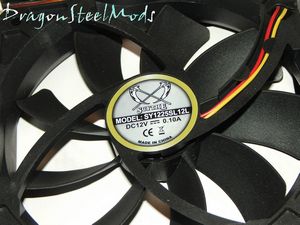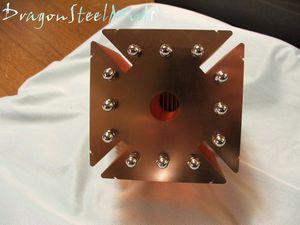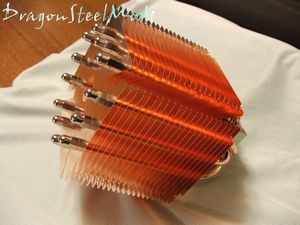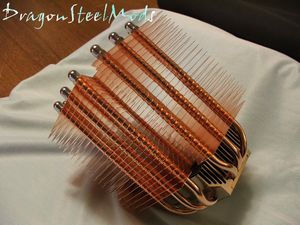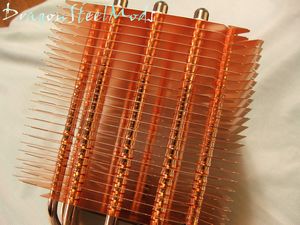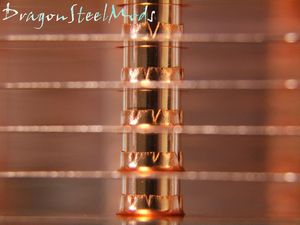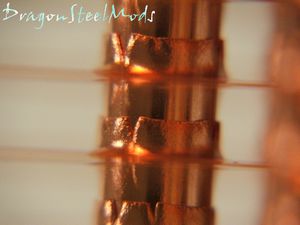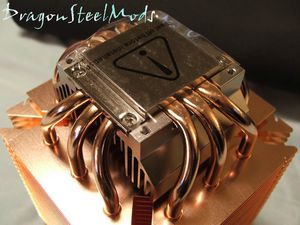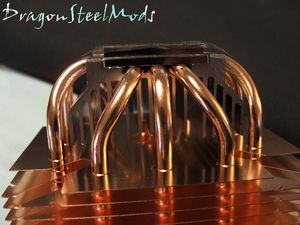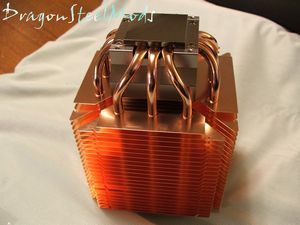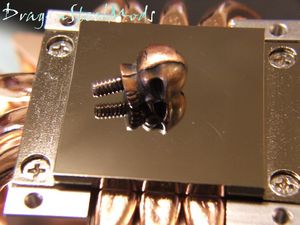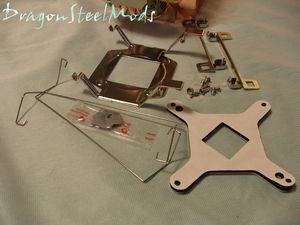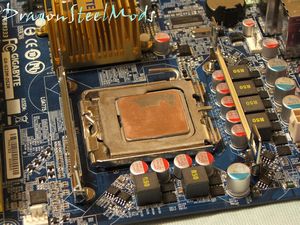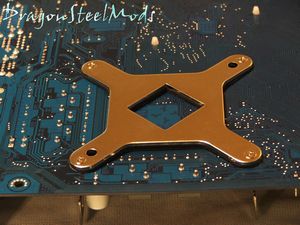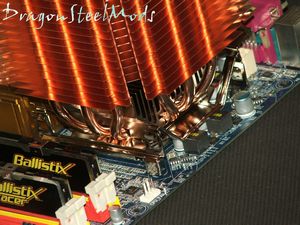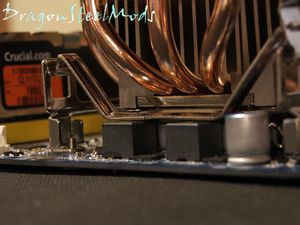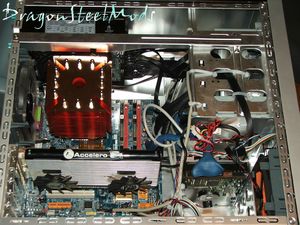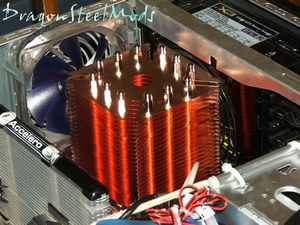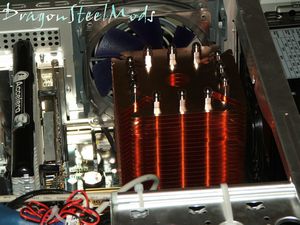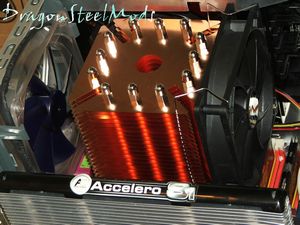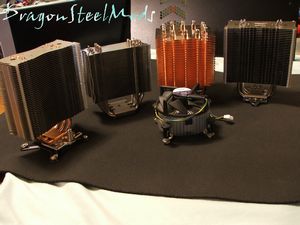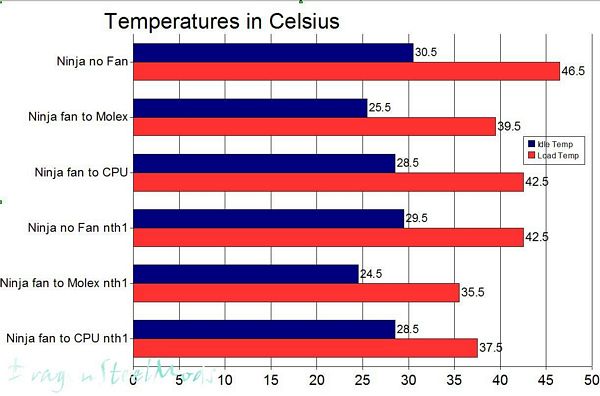Today we've got another CPU cooler up on the review block, been doing a lot of those lately, and I just got another one in for review yesterday… Anyway, the cooler I have for review today is one that many people have been talking about all over the internet, it's one that those same people and others have been waiting for its' arrival with baited breath and sweet anticipation, it's the Scythe Ninja Copper Anniversary Model CPU Cooler, and yeah… it's all that! So, I don't think anymore introduction is needed…. hit it.
Scythe Ninja Copper Anniversary Model CPU Cooler
Author: Kristofer Brozio
Sponsor: Scythe
Tech Specs,Features or the Basic Info:
Scythe Ninja Copper
Model name:
Ninja Cu CPU Cooler
Model no.:
SCNJ-CU1000
Compatibility:
Intel:
Socket 478 all speeds
Socket T / (LGA) 775 all speeds
AMD:
Socket 754 all speeds
Socket 939 all speeds
Socket 940 all speeds
Socket AM2 all speeds
Dimensions (WxDxH):
110x110x150mm (overall dimensions)
120x120x25mm (fan extent)
Fan speed:
800rpm (± 10%)
Fan noise level:
10.70 dBA
Air Flow:
40.17 CFM
Weight:
1015g (+115 g fan)
(Editor's Note: The fan that comes with the Ninja Copper is actually the Scythe SlipStream 120mm 800RPM fan that we reviewed HERE not long ago.)
A Better Look at Things
:
The first thing we look at with any product is of course the packaging, the Ninja is done in the very familiar Scythe style that's a bit flashy with lots of information all of the box.
The first thing we see when we open the box is the included 120mm fan, and looking closer we can see it's a model SY1225SL12L which means it's an 800RPM fan and one of the new line of fans from Scythe called the SlipStream. (If you wish to check out our review of all of the models of SlipStream fans you can go HERE).
It's a CPU cooler so of course packed along with the cooler are all the mounting hardware needed for several different platforms. Included also is a pack of thermal compound, metal clips to attach the fan to the Ninja and of course instructions for installation.
The all copper of the Ninja makes it very attractive, at least in my opinion, I've always liked the color of copper, and of course we know that copper is a much better conductor or heat. The all copper does make it very bright and very reflective to light, it was rather difficult to get pictures of this cooler using a flash so I opted not to.
The Scythe Ninja Copper looks almost identical to the original Scythe Ninja with the same dimensions and the same number of fins, but the original Ninja weighs in at 665Grams, the Ninja Rev2 at 640Grams and the Ninja Copper weighing a whopping 1015Grams, and that's without the fan… when UPS dropped this off to me I thought there was a brick in the box instead of a CPU cooler…
A Better Look at Things
Continued:
I owned the original Ninja when it first came out, I no longer have it as I gave it away, but from what I can tell the fins seem a tiny bit thicker ion the copper version than the original. One thing I do remember about the Ninja is how sharp the fins were, I sliced my hands open quite a few times while installing it. I did cut my hand once on the copper version but it was just a nick, but the point is that the fins seem thicker and not as easily bendable as the original version.
Here's a few shots of the fins and some close-ups as well:
The Ninja Copper has got 12 or 6 heatpipes, depending on how you look at it, it has 12 lengths or 6 U-shaped pipes. The pipes originate in the base as expected and are sandwiched between the base plate and another smaller heatsink to help further promote cooling.
The actual base of the Ninja Copper has a mirror finish and appears to be flat, very fine machining marks can be seem if you look closely, overall though nicely done.
Installation, Testing and Comparison
Since you need to use a backplate with the Scythe Ninja Copper you'll need to remove the motherboard from the case to do the installation. Once you've gathered up the parts for the platform you're using you can get started, for my installation I'm using the LGA775 setup.
The first thing you need to do is attach the correct bracket to the Ninja itself, this is done be securing it with four small screws.
The second thing you'll need to do is of course affix the back and front of the CPU socket mounts to your motherboard, this can be tricky and it almost requires a third hand. Installation involves holding the screw, backplate, washer on front side and the bracket itself, I dropped it quite a few times before I got it installed… I didn't run into any problems with the brackets fitting my motherboard but it was very close, the bracket just fits across the tops of the capacitors on my motherboard.
After the bracket is installed you can then apply the thermal compound and install the Ninja itself. The ninja cleared all of the major large components on my motherboard easily, even the fairly large northbridge heatsink and the ram that is located close to the CPU socket.
One thing I did notice is that the mounting bracket on the Ninja was almost sitting on the chokes of my motherboard, there was maybe a millimeter clearance, had they been a bit taller I wouldn't have been able to complete the installation.
My testing setup is as follows:
-Intel P4 Extreme Edition 955 CPU @ 3.46GHZ
-Gigabyte GA-G33M-DS2R LGA775 Motherboard
-Crucial Ballistix Tracer DDR2 PC2-8500 (2x1gig)
-Connect3d X1800GTO Video Card
-Ultra X3 800-Watt Modular Power Supply
-1x hard drive
-1x dvd/rw drive
-2x 120mm case fans, (1 intake and 1 exhaust)
-all housed in a Thermaltake Matrix VX case
Installation, Testing and Comparison Continued:
Since the Scythe Ninja is so large I was expecting issues with clearance inside the case but I really didn't find any, although installing the fan after I finished my testing without it proved to be a challenge. Also if you need to remove the Scythe Ninja for any reason it's near impossible without removing the motherboard from case again unless you remove the cooling fan from the back as with my case and power supply as well to provide room to get your fingers under the Ninja to unlock the clips.
Here's a picture of the Scythe Ninja and other coolers I've got on hand for comparison (from left to right: Coolink Silentator, Thermalright Ultima 90, Scythe Ninja, Noctua NH-U12P and the Intel Stock Cooler down in front)
Since I've reviewed quite few coolers lately I've included them in the following charts as well for comparison, in the chart you'll see temps for the Ninja with no fan, fan connected to Molex running at 800RPM, and the fan connected to the CPU header running at 600RPM. You'll also see temperatures for the Thermalright Ultima90, GlacialTech Silent and PWM Coolers, Noctua NH-U12P, Coolink Silentator and the Intel Stock CPU Cooler.
Please note that since the Scythe Ninja came with it's own thermal compound I used that for my first round of testing to give an idea of out-of-the box performance, so the first graph is the results I got using the included compound. You can click the graph to open in another window at 1024×768 resolution to get a better look at it. To achieve load on the CPU I used Orthos Stress Prime. Ambient room temperature during all testing was approximately 20C.
While the results shown above are good overall I was thinking they should be better so I ran my tests again, but this time using the Noctua NT-H1 thermal compound to see if using a name brand would help improve things and of course it did. (again you can click to see larger)
As you can see the temperatures have dropped quite a bit while under load, not much difference at idle but an average of four degrees under load so we can see that just be using a different compound things can change significantly.
So here's another graph with just the temperatures of the Scythe using the stock thermal compound and using the NT-H1 thermal compound for a better comparison of them: (again you can click to see larger view)
So obviously if you're thinking about getting the Scythe Ninja Copper you'll also need to get a tube of decent thermal compound to achieve maximum cooling efficiency. Of course for possibly even better cooling you could use another fan in the push-pull configuration or even switch to a higher RPM/airflow type of fan. I've tried to cover a lot in this review but of course I can't cover every possible configuration out there… so it's up to the end user to decide which is best for him or her.
Summary:
The Scythe Ninja is a great cooler, especially when you consider it can be used with no fan at all and achieve nice low temperatures for you CPU. It easily competes with the top coolers out there today in terms of performance and design.
I've always liked Scythe products and this is just another reason to be a fan of them.
The only drawback I can see and the reason it won't get a perfect score is the possibility of clearance issues with certain motherboards and of course the cheap thermal compound that is included with it.
DragonSteelMods gives the Scythe Ninja Copper a 4.5 out of 5 score and our Recommended Award as well.


Pros:
-Looks cool
-Excellent cooling performance
-Can be used without a fan
-Very well made
-Silent fan included
Cons:
-Installation can be difficult in tight cases
-Depending on motherboard configuration cooler might not fit
-Very heavy
I would like to thank Scythe for the chance to review the Ninja Copper CPU Cooler and for their continued support of DSM.
Discussion and questions HERE
{amazon id='B000ALXVC8' align='RIGHT'}
review# 359

